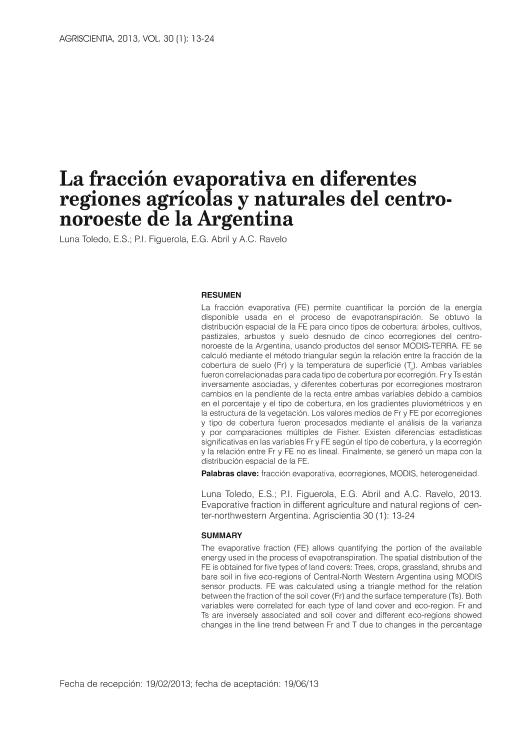Mostrar el registro sencillo del ítem
dc.contributor.author
Luna Toledo, Emanuel Santiago

dc.contributor.author
Figuerola, Patricia Irene

dc.contributor.author
Abril, Ernesto Guillermo

dc.contributor.author
Ravelo, Andres Carlos

dc.date.available
2017-09-19T16:09:24Z
dc.date.issued
2013-06
dc.identifier.citation
Luna Toledo, Emanuel Santiago; Figuerola, Patricia Irene; Abril, Ernesto Guillermo; Ravelo, Andres Carlos; La fracción evaporativa en diferentes regiones agrícolas y naturales del centronoroeste de la Argentina; Universidad Nacional de Cordoba. Facultad de Ciencias Agropecuarias; AgriScientia; 30; 1; 6-2013; 13-24
dc.identifier.issn
0327-6244
dc.identifier.uri
http://hdl.handle.net/11336/24584
dc.description.abstract
La fracción evaporativa (FE) permite cuantificar la porción de la energía disponible usada en el proceso de evapotranspiración. Se obtuvo la distribución espacial de la FE para cinco tipos de cobertura: árboles, cultivos, pastizales, arbustos y suelo desnudo de cinco ecorregiones del centro-noroeste de la Argentina, usando productos del sensor MODIS-TERRA. FE se calculó mediante el método triangular según la relación entre la fracción de la cobertura de suelo (Fr) y la temperatura de superficie (Ts). Ambas variables fueron correlacionadas para cada tipo de cobertura por ecorregión. Fr y Ts están inversamente asociadas, y diferentes coberturas por ecorregiones mostraron cambios en la pendiente de la recta entre ambas variables debido a cambios en el porcentaje y el tipo de cobertura, en los gradientes pluviométricos y en la estructura de la vegetación. Los valores medios de Fr y FE por ecorregiones y tipo de cobertura fueron procesados mediante el análisis de la varianza y por comparaciones múltiples de Fisher. Existen diferencias estadísticas significativas en las variables Fr y FE según el tipo de cobertura, y la ecorregión y la relación entre Fr y FE no es lineal. Finalmente, se generó un mapa con la distribución espacial de la FE.
dc.description.abstract
The evaporative fraction (FE) allows quantifying the portion of the available energy used in the process of evapotranspiration. The spatial distribution of the FE is obtained for five types of land covers: Trees, crops, grassland, shrubs and bare soil in fve eco-regions of Central-North Western Argentina using MODIS sensor products. FE was calculated using a triangle method for the relation between the fraction of the soil cover (Fr) and the surface temperature (Ts). Both variables were correlated for each type of land cover and eco-region. Fr and Ts are inversely associated and soil cover and different eco-regions showed changes in the line trend between Fr and T due to changes in the percentage and type of coverage, the rainfall gradients and vegetation structure. The mean values of Fr and FE for cover type and eco-regions, were processed using the analysis of variance and the multiple comparison test of Fisher. Statistically significant differences were found in Fr and FE according to type of land cover and eco-region and there is a nonlinear relationship between Fr and FE. Finally, a map was generated showing the spatial distribution of FE.
dc.format
application/pdf
dc.language.iso
spa
dc.publisher
Universidad Nacional de Cordoba. Facultad de Ciencias Agropecuarias
dc.rights
info:eu-repo/semantics/openAccess
dc.rights.uri
https://creativecommons.org/licenses/by-nc-sa/2.5/ar/
dc.subject
Fracción Evaporativa
dc.subject
Ecorregiones
dc.subject
Modi
dc.subject
Heterogeneidad
dc.subject.classification
Ingeniería Oceanográfica

dc.subject.classification
Ingeniería del Medio Ambiente

dc.subject.classification
INGENIERÍAS Y TECNOLOGÍAS

dc.title
La fracción evaporativa en diferentes regiones agrícolas y naturales del centronoroeste de la Argentina
dc.title
Evaporative fraction in different agriculture and natural regions of center-northwestern Argentina
dc.type
info:eu-repo/semantics/article
dc.type
info:ar-repo/semantics/artículo
dc.type
info:eu-repo/semantics/publishedVersion
dc.date.updated
2017-09-19T14:19:50Z
dc.identifier.eissn
1668-298X
dc.journal.volume
30
dc.journal.number
1
dc.journal.pagination
13-24
dc.journal.pais
Argentina

dc.journal.ciudad
Córdoba
dc.description.fil
Fil: Luna Toledo, Emanuel Santiago. Universidad Nacional de Chilecito; Argentina. Consejo Nacional de Investigaciones Científicas y Técnicas; Argentina
dc.description.fil
Fil: Figuerola, Patricia Irene. Universidad Nacional de Chilecito; Argentina. Consejo Nacional de Investigaciones Científicas y Técnicas; Argentina
dc.description.fil
Fil: Abril, Ernesto Guillermo. Consejo Nacional de Investigaciones Científicas y Técnicas. Centro Científico Tecnológico Córdoba. Instituto Multidisciplinar de Biología Vegetal (p). Grupo Vinculado Centro de Relevamiento y Evaluacion de Recursos Agricolas y Naturales; Argentina
dc.description.fil
Fil: Ravelo, Andres Carlos. Consejo Nacional de Investigaciones Científicas y Técnicas. Centro Científico Tecnológico Córdoba. Instituto Multidisciplinar de Biología Vegetal (p). Grupo Vinculado Centro de Relevamiento y Evaluacion de Recursos Agricolas y Naturales; Argentina
dc.journal.title
AgriScientia
dc.relation.alternativeid
info:eu-repo/semantics/altIdentifier/url/http://ref.scielo.org/733wny
dc.relation.alternativeid
info:eu-repo/semantics/altIdentifier/url/https://revistas.unc.edu.ar/index.php/agris/article/view/6048
Archivos asociados
